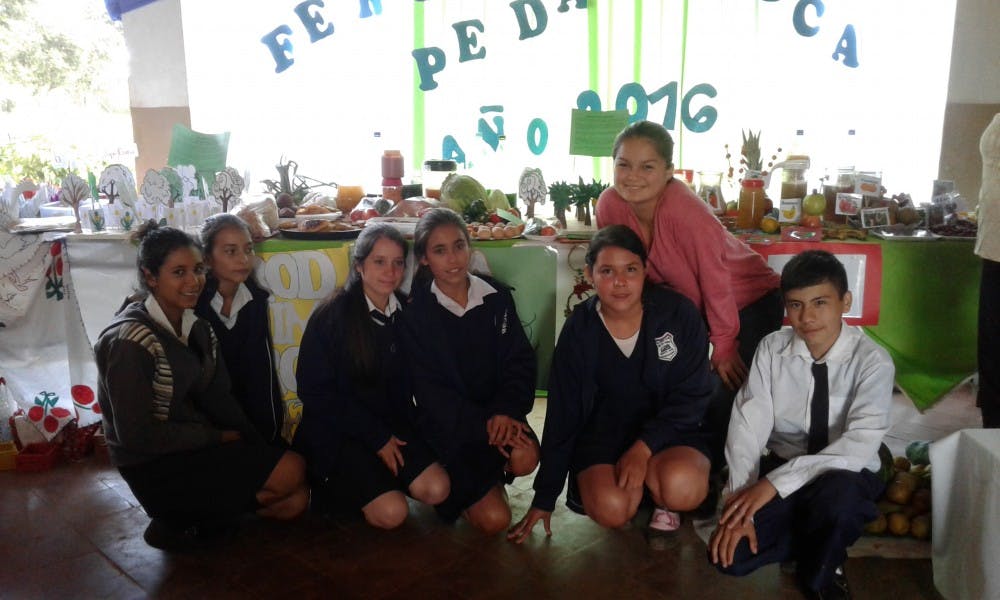AU alumna Katherin Sibel spends her days speaking Guarani, the national language of Paraguay. That’s where she’s stationed as a Peace Corps volunteer, managing several women’s agribusiness projects and social development programs within the Latin American community.
In February, the Peace Corps named AU a top provider of volunteers from medium-sized schools. Sibel, who graduated from the School of International Service in 2015, is one of 54 from AU serving in the Peace Corps right now.
In fact, AU has indoctrinated Peace Corps’ mission within the classroom since the early 1960s, and continues to do so today.
“As a volunteer, I find myself doing various activities throughout the weeks with different peoples and groups in the community,” Sibel said in an email. “This ranges from planting in gardens and farms, trash cleanups, teaching English and other skills needed with Paraguayans of all ages.”
Twenty-two of the 54 representing AU are education volunteers, and 13 are health volunteers, Emily Webb, Public Affairs Specialist at Peace Corps, said in an email. Others are serving as agriculture, youth development, or community and economic development volunteers.
Revisiting a focus on undergraduates
Although AU has historically produced high numbers of Peace Corps volunteers, in February 2016, without a clear explanation as to why, Peace Corps decided to end its master’s international degree program, which AU offered through SIS.
Numerous undergraduates have asked Stephen Angelsmith, Director of Peace Corps Programs at SIS, over his five years with AU about how they can get involved as a volunteer.
Over the last two years, the Peace Corps and SIS developed a new certificate program, the Peace Corps Prep, to give undergraduates a pathway to the Peace Corps, Angelsmith said.
“The new certificate program is a series of courses, that at the end of graduation, you will also earn a Peace Corps Prep certificate,” Angelsmith said. “It’s a social organization to prepare students for international service.”
Twelve undergraduate SIS students started the certificate program in February, while about 35 students applied. Ideally, the students should apply at the beginning of their sophomore year. However, all grade levels are encouraged to apply since much of the course work in SIS already crosses over into the certificate’s requirements, Angelsmith said.
Having the certificate is not a guarantee for acceptance into the organization, but going through the series of courses at SIS will greatly improve a student’s chance for being accepted, Webb said.
Angelsmith, who served in Turkmenistan 10 years ago and is now a returned volunteer, said the certificate is a shared experience of coursework and service. Furthermore, the new curriculum provides SIS undergraduates with professional skills and intercultural competencies to possibly join the Peace Corps after graduation, Angelsmith said.
Designed for SIS undergraduate students, he said the certificate will broaden students’ education and experience so that they may implant creative, individual development projects across the globe.
Opposing opinions
However, not all faculty and students are fond of the Peace Corps.
AU Professor Daniel Esser said that he and many of his students have mixed opinions about the usefulness of the program. Some see value in the grassroots approach of the Peace Corps’ mission, while others see the Peace Corps as more beneficial to the volunteer than the host country, he said.
For that, Esser agrees.
Esser said that he’s seen little evidence that Peace Corps volunteers substantially help with development efforts for other countries. By design, the program is not at all sustainable, he said, because the volunteer arrives, works on a project, and then leaves. There may be exceptions, but not much, he said.
“The stereotypical volunteer is a Democrat, middle-class white person,” he said. “And at twenty-two years old, we’re sending fairly skill-less volunteers.”
Angelsmith said he is aware of what dissenters say about sending over wealthier volunteers, as opposed to those in lower socioeconomic backgrounds. Since the Peace Corps is unpaid, people from lower socioeconomic backgrounds may not be able to volunteer, or feel as though they have access to the program, Angelsmith said, because of the loss of income over two years.
However, he said the Peace Corps offers benefits that fray the costs of being away from home.
“Peace Corps volunteers are not being paid a salary at home, but you have health insurance and student loans can be deferred,” he said. “The Peace Corps pays for everything while you are volunteering.”
Another aspect for future volunteers to consider is how much time they are away from family and friends, Angelsmith said.
Sibel, who will be closing service on Dec. 7 of this year, said that social media has helped her stay connected with family and friends at home, if internet service is available.
Her advice for new Peace Corps volunteers is to take full advantage of being immersed in a new culture and country.
“When you first get into your site, enjoy making connections for the first few months or year,” Sibel said. “Get to know the people, and get into the language, culture, and community vibe. The more vulnerable you are in sharing with the community that is hosting you, the more at home you will feel.”
sdolezal@theeagleonline.com





